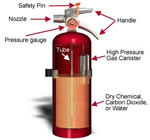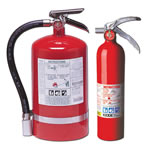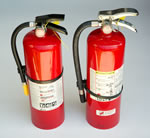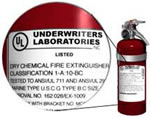Hot Issue: Automotive Fire Extinguishers - Page 2 of 4
 |
 |
by Hib Halverson
© November 2012
No use without permission, All Rights Reserved
Extinguishers and Their Agents
Portable fire extinguishers small enough to be carried in your car, or somewhat larger units to hang on the wall in your garage, are designed to put out a fire in its early stages-typically the first two minutes-before it grows such that significant damage to the vehicle or home or injury to the occupants takes place. Once the fire is larger than that, forget hand extinguishers. Run the other way to a safe location then dial 911 because you need a fire truck-not a fire extinguisher.
Portable extinguishers are often the “stored pressure” type, meaning they are filled with a fire suppression or extinguishing agent and then pressurized, usually with either nitrogen gas, CO2 or air. They are metal cylinders, either steel or aluminum, topped with a handle and a lever. When you push the lever down by squeezing it and the handle together, a valve opens. The gas pressure is released and forces the extinguishing agent out of the cylinder, through the valve and out through (small extinguishers) a nozzle or (larger extinguishers) a short hose with a nozzle at the end. A pressure gauge mounted on the handle assembly tells the user if the extinguisher is fully charged. A ring pin locks the lever and handle and must be removed or “pulled” before the extinguisher can be used.
Portable fire extinguishers use a variety of extinguishing agents: water, carbon dioxide (CO2), dry chemical powders and so-called “clean agents”. These fire suppression agents are rated by the class or classes of fire for which they are effective.
Water is great as long as you are fighting a Class A fire. Class B, C or D? Don’t use water. It may spread a Class B fire. You can be shocked or electrocuted if you use it on a Class C fire. Spray water on a Class D fire and an explosion will result.
CO2 shouldn’t be used on a class-A fire because it may spread rather than suppress it. Even if it doesn't spread the fire, CO2 is not very effective on a Class A fire because it may not displace enough oxygen to extinguish the fire. CO2 can be effective on B and C fires and is one of the agents recommended for fire suppression in places where the extinguishing agent residue can cause problems after the fire is out.
Dry chemical agents are widely used in fire extinguishers carried in vehicles or intended for initial fire suppression in garages or work areas. Three types of dry chemical powders are common.
ABC-rated, “multi-purpose dry chemical” fire suppression agent (some call it “ABC dry chem”) is mono-ammonium phosphate powder and is often used in stored pressure extinguishers. When sprayed on a Class A fire, at 350°F, it melts, then coats the fuel making a barrier between it and oxygen. It breaks the chain reaction in a Class B fire. It is, also, a Class C extinguishing agent meaning it will not conduct electricity, so current will not flow from the burning electrical components, up the stream of extinguishing agent, through the metal of the extinguisher and into your body. If moisture is present, ABC dry chem is mildly corrosive so, the contacted area should be cleaned once the fire is out. Fire extinguishers charged with ABC dry chem are the best choice for fighting vehicle or small garage fires.
Another common fire suppression agent is “regular dry chemical” which is ordinary sodium bicarbonate-baking soda. It was the first dry chemical extinguishing agent developed and is often used in lower cost extinguishers. Sodium bicarbonate is B:C-rated but is not as effective as ABC dry chem and is not effective on Class A fires.
A third type of dry chemical agent with which Corvetters might come in contact, though not often because of its cost, is potassium carbonate, commonly known as “Purple-K”. It’s Class-B:C-rated and is common in military, industrial or commercial environments where gasoline, solvents, oil or flammable gases are processed, handled or stored. Purple-K is the dry chemical agent of choice for the oil and gas industry and the only dry chemical agent approved for aircraft fires. Of all common fire suppression agents covered here, it’s the most effective at suppressing Class B fires.
Some automotive extinguishers use hydroflurocarbon (HFC) gases, also called “clean agents," such as Kidde “Halotron, Ansul “FE-36 CLEANGUARD," HFC-227ea and others. HFCs work by one or combination of: displacing oxygen, removing heat from the combustion zone or inhibiting the chemical chain reaction. The attraction of HFCs are, when the fire extinguisher is discharged, there is no cloud of yellow, white or purple powder and there is no corrosive residue to clean up after the fire is out-which you might think is a good thing if the fire is under the hood of your pristine ’69 427/435 Convertible. The downsides of HFC agents are: 1) high cost, both initial purchase and refilling, and 2) for a given fire extinguisher size, they puts out less fire than do dry chemical fire extinguishers.
Our view is that if your car is on fire, first priority is to make sure you and your passengers are safe and the second priority is to get the fire out and, for a given extinguisher size, ABC dry chemical can put out a much larger fire or can be discharged for a longer period than can an extinguisher using an HFC agent. For carrying in the car, we’ll take ABC dry chem and a clean up job vs. HFC and, perhaps, an ineffective fire suppression attempt.
Class D fire extinguishers are uncommon in the automotive enthusiast community because of the rarity of metal fires and the cost of the extinguisher, but if you regularly do metal finishing work on aluminum parts and generate a lot of filings, powder or dust; you should consider one. Class D extinguishers for aluminum fires use sodium chloride-salt crystals as an extinguishing agent.
Rating Numbers
While all extinguishers are rated for the fire class for which they are effective, Class A and B units are, also, rated as to the size of fire they can extinguish and, for Class B extinguishers, for how long they can be discharged. The testing and rating of fire extinguishers is done by Underwriters Laboratories and the procedure is complicated. We should add that one should never use a fire extinguisher for vehicle or workshop protection which is not UL-rated.
If the extinguisher carries an “A” rating, such as “1-A:10-B:C,” the number before the “A” designates the size of a burning crib of wood which can be extinguished by an experienced user. A rating of 1-A means that extinguisher can put out a burning, 20x20x24-in crib of 2x2-in. boards (9600 cu.in.), stacked in 12 layers of six pieces. A 2-A extinguisher can put out a 20,000 cu.in. crib (25x25x32-in of 2x2s) and each jump in a rating number doubles the volume of the crib it can extinguish.
With Class B extinguishers, the numeric rating is 40% of the area of a four-inch deep pan of burning heptane, a flammable solvent which is a minor component of gasoline. If an Underwriters Laboratories Fire Fighter-the “UL Expert”-can put out a 25 sq.ft. pan of heptane with a given fire extinguisher, its rating is 10-B. If it’s capable of putting out a fire twice that size, it’s rating is 20-B and so on.
It is important to remember that the numeric rating on a Class A or B extinguisher is merely a guideline one can use to compare extinguishers. It does not accurately quantify how large a fire the average user can put out because, with a given fire extinguisher size, a UL Expert in a laboratory testing environment is going to be able to extinguish a bigger fire than can an inexperienced user in a real world situation. Also atmospheric conditions, fire location, fuel type will affect the fire suppression effort such that the extinguisher in question may have an effect in the "real world" quite different from what happened during the rating process.
 |
 |





